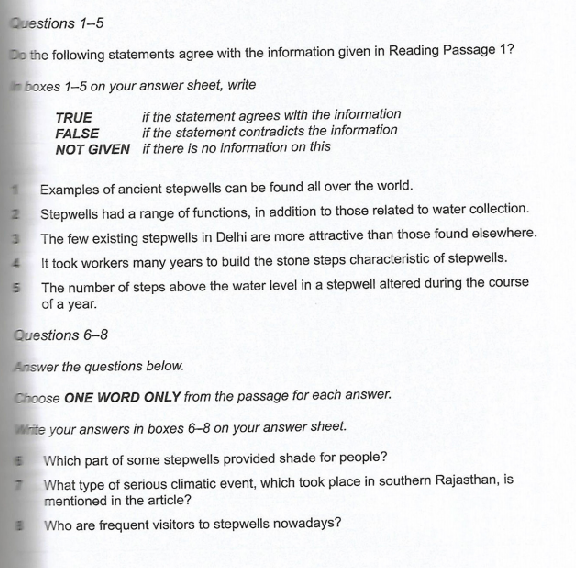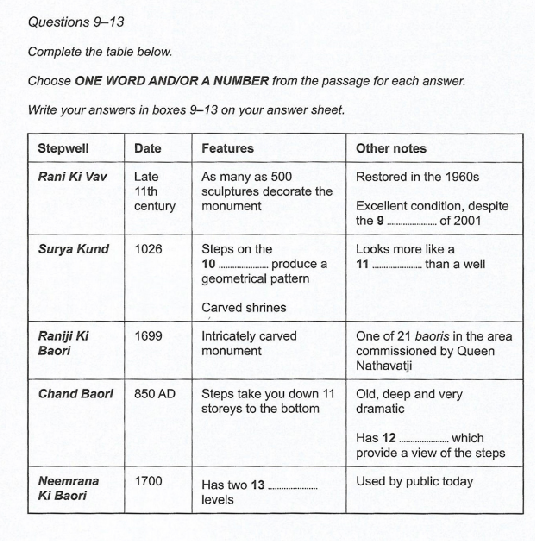剑桥雅思10阅读:Test1雅思阅读PASSAGE1真题+答案+解析
发布时间:2021-01-29 关键词:想必烤鸭都有剑10真题,刷过剑10真题的同学,对于剑10真题有不解。没关系,这些疑问,新航道雅思辅导班会在今后为你一一揭开谜底。今天带了的是剑桥真题10test1雅思阅读真题译文passage1。
剑10test1passage1真题文本
Stepwells
A millennium ago, stepwells were fundamental to life in the driest parts of India. Richard Cox travelled to north-western India to document these spectacular monuments from a bygone era.
During the sixth and seventh centuries, the inhabitants of the modern-day states of Gujarat and Rajasthan in north-western India developed a method of gaining access to clean, fresh groundwater during the dry season for drinking, bathing, watering animals and irrigation.However, the significance of this invention - the stepwell - goes beyond its utilitarian application.
Unique to this region, stepwells are often architecturally complex and vary widely in size and shape. During theirheyday, they were places of gathering, of leisure and relaxation and of worship for villagers of all but the lowest classes. Most stepwells are found dotted round the desert areas of Gujarat (where they are called vav) and Rajasthan (where they are called baori), while a few also survive in Delhi. Some were located in or near villages as public spaces for the community; others were positioned beside roads as resting places for travellers.
As their name suggests, stepwells comprise a series of stone steps descending from ground level to the water source (normally an underground aquifer) as it recedes following the rains. When the water level was high, the user needed only to descend a few steps to reach it; when it was low, several levels would have to be negotiated.
Some wells are vast, open craters with hundreds of steps paving each sloping side, often in tiers. Others are moreelaborate, with long stepped passages leading to the water via several storeys. Built from stone and supported by pillars, they also included pavilions that sheltered visitors from the relentless heat. But perhaps the most impressive features are the intricate decorative sculptures that embellish many step wells, showing activities from fighting and dancing to everyday acts such as women combing their hair or churning butter.
Down the centuries, thousands of wells were constructed throughout northwestern India, but the majority have now fallen into disuse; many are derelict and dry, as groundwater has been diverted for industrial use and the wells no longer reach the water table. Their condition hasn’t been helped by recent dry spells: southern Rajasthan suffered an eight-year drought between 1996 and 2004.
However, some important sites in Gujarat have recently undergone major restoration, and the state government announced in June last year that it plans to restore the stepwells throughout the state.
In Patan, the state's ancient capital, the stepwell of Rani Ki Vav (Queen’s Stepwell) is perhaps the finest current example. It was built by Queen Udayamati during the late 11th century, but became silted up following a flood during the 13th century. But the Archaeological Survey of India began restoring it in the 1960s, and today it is in pristinecondition. At 65 metres long, 20 metres wide and 27 metres deep, Rani Ki Vav features 500 sculptures carved into niches throughout the monument. Incredibly, in January 2001, this ancient structure survived an earthquake that measured 7.6 on the Richter scale.
Another example is the Surya Kund in Modhera, northern Gujarat, next to the Sun Temple, built by King Bhima I in 1026 to honour the sun god Surya. It actually resembles a tank (kund means reservoir or pond) rather than a well, but displays the hallmarks of stepwell architecture, including four sides of steps that descend to the bottom in a stunning geometrical formation. The terraces house 108 small, intricately carved shrines between the sets of steps.
Rajasthan also has a wealth of wells. The ancient city of Bundi, 200 kilometres south of Jaipur, is renowned for its architecture, including its stepwells.
One of the larger examples is Raniji Ki Baori, which was built by the queen of the region, Nathavatji, in 1699. At 46 meters deep, 20 metres wide and 40 metres long, the intricately carved monument is one of 21 baoris commissioned in the Bundi area by Nathavatji.
In the old ruined town of Abhaneri, about 95 kilometers east of Jaipur, is Chand Baori, one of India's oldest and deepest wells; aesthetically it’s perhaps one of the mostdramatic. Built in around 850 AD next to the temple of Harshat Mata, the baori comprises hundreds of zigzagging steps that run along three of its sides, steeply descending11 storeys, resulting in a striking pattern when seen from afar. On the fourth side, verandas which are supported byornate pillars overlook the steps.
Still in public use is Neemrana Ki Baoriy located just off the Jaipur-Delhi highway. Constructed in around 1700, it is nine storeys deep, with the last two being underwater. At ground level, there are 86 colonnaded openings from where the visitor descends 170 steps to the deepest water source.
Today, following years of neglect, many of these monuments to medieval engineering have been saved by the Archaeological Survey of India, which has recognised the importance of preserving them as part of the country’s rich history. Tourists flock to wells in far-flung corners of northwestern India to gaze in wonder at thesearchitectural marvels from hundreds of years ago, which serve as a reminder of both the ingenuity and artistry of ancient civilisations and of the value of water to human existence.
剑桥真题10test1雅思阅读真题译文passage1-印度阶梯井
千年之前,在印度最干旱的地区,阶梯井是人们必备的生活基础设施。理查德·考克斯游历至印度西北部,如实记述了这些令人叹为观止的历史古迹。
六至七世纪期间,在今印度西北部古吉拉特邦和拉贾斯坦邦,当地居民发明了一种取水的方法,可以在旱季获得清冽干净的地下水,以满是人畜生活用水和农业灌溉。然而,阶梯丼的重要性远不止于此。
阶梯井是当地独有的发明,它们往往架构复杂,在大小和形状方面差异很大。在阶梯井的全盛时期,它们还是村民聚会和娱乐休闲的地方,同时也是村民(层的贱民阶级除外)拜神的场所。现存的大多数阶梯井散布在古吉拉特邦(当地人们称之为vav)和拉贾斯坦邦(当地人们称之为baori)的沙漠地区,德里也有一些幸存遗迹。村子里面或者村口附近的阶梯井是村民的公共场所,路边的阶梯井则作为旅行者歇脚的地方。
顾名思义,阶梯井是由一系列的石阶组成,石阶从地面向下直通到水源(通常是地下含水层)。该地下水源的水位会在雨季过后降低。水位高时,用户只需拾级而下几步即可取水;水位低时,用户则需更深入阶梯井方可取水。
有些阶梯井是巨大的露天的坑洞,沿着每一个斜坡的坡面修了数以百计的台阶,通常分为数层。有些则更为精致复杂,阶梯层层分布,形成长长的通道直通水面。阶梯井是由石头筑成,且由廊柱支撑,还带有亭子提供荫凉,保护人们免受酷热的折磨。但最令人印象深刻的,也许是阶梯井中那些错综精美的装饰性雕塑。这些雕塑展示了人们的各种活动,有战斗和舞蹈,也描述了许多日常行为,如妇女梳头和搅拌黄油。
几个世纪以来,人们在印度西北部地区修建了数千座阶梯井,但现在绝大多数已经废弃不用;随着地下水被转为工业用途,以及地下水位的下降,许多阶梯井已经干涸破败。而近年来的干旱期更是雪上加霜:1996年至2004年,拉贾斯坦邦南部连续8年大早。
所幸古吉拉特邦的一些重要的阶梯井近期已被修复,而且印度政府去年6月份宣布计划整修境内所有的阶梯井。
古都帕坦的王后阶梯井(Rani Ki vav)也许是其中现存的最精美的一个。11世纪晚期时,这座阶梯井由王后乌达雅玛蒂下令建造;但在13世纪的一场洪水中,该阶梯井被淤泥堵塞。20世纪60年代印度考古局开始对它进行修复,如今它已恢复原貌。王后阶梯井长65米,宽20米,深27米,整座阶梯井嵌有500座雕像。不可思议的是,在2001年1月,这座古建筑在一场里氏7.6级的地震中幸存下来。
另一座的阶梯井是位于古吉拉特邦北部莫德拉的Surya Kund。它毗邻太阳神庙。1026年,国王Bhima一世为了纪念太阳神Surya建造了这座阶梯井。它的外形其实更像一个水池(kund的意思是水池或水塘)而不是水井,但它具备阶梯井的特征:四面都是台阶,以一种绝妙的几何排列延伸到底部。在各组台阶之间供奉有108个雕刻精美的小型神龛。
拉贾斯坦邦也有的阶梯井。位于斋浦尔以南200公里的古城本迪以建筑而闻名,其中就包括阶梯井。其中的一座阶梯井叫Raniji Ki Baori,它由该地区的王后Nathavatji在1699年下令建造。这座阶梯井深46米、宽20米、长40米,是一座雕刻精美的古迹。它是王后Nathavatji在本迪地区下令建造的21座阶梯井(baoris)之一。
在斋浦尔以东约95公里的古城遗址Abhaneri,有一座阶梯井叫Chand Baori。它是印度年代最久、最深的井之一;从审美角度来说,也可能是最引人注目的井之一。这座阶梯井建造于公元850年左右,毗邻Harshat Mata神庙。数百级蜿蜒的台阶环绕其中三面,上下纵深11层,陡峭。从远处看,极为醒目。最后一面则是由装饰华丽的廊柱支撑的走廊,俯瞰台阶。
至今还在使用中的阶梯井是Neemrana Ki Baori,位于斋浦尔至德里高速路旁。这座阶梯井建造于1700年左右,上下9层,最下面的两层位于水下。在地面则有86个廊柱入口,游客们由此走下170级台阶就可以到达水源最深处。
如今,许多用中世纪工程学建造的古迹在多年无人问津之后,被印度考古局拯救。他们意识到了保护这些遗迹的重要性,因为它们是这个悠久历史的一部分。游客们蜂拥而至印度西北部这个偏远的角落,来一睹这些数百年前的建筑奇迹,它们展示了古代文明的精巧和艺术性,同时也提醒了人们水对人类生存的重要价值。


Question 1
参考译文:古老阶梯水井的例子在全世界范围内都能发现。难度及答案:难度低;答案为 FALSE
关键词:all over the world
定位原文: 第 2 段第 1 句“Unique to this region... ”阶梯水并是这个地区独有的。
解题思路: 原文说阶梯水井是这个地区独有的,题目说全世界都有,所以答案为 FALSE。
Question 2
参考译文:除了收集水资源以外,阶梯水井达有功能。难度及答案:难度低;答案为 TRUE
关键词:functions
定位原文:第 2 段第 2 句“During their heyday... ”在它们的全盛期,它们是聚集的场所, 是娱乐放松的场所,是除了底层阶级以外村民拜神的场所。
解题思路:原文中介绍了功能,比如娱乐,所以答案为 TRUE。
Question 3
参考译文: 德里(Delhi)现存的阶梯水井比其他地区发现的水井更具有吸引力。难度及答案:难度低;答案为 NOT GIVEN
关键词:Delhi
定位原文:第 2 段第 3 句“Most stepwells…”大多数的阶梯水井被发现散落在吉拉特邦(他们称之为 vov)和拉贾斯坦邦(他们称之为 baori)的沙漠地带,还有少量的在德里发现。
解题思路:原文并没有对它们的吸引力做出比较,所以答案为 not given。
Question 4
参考译文:工人们需要花费年才能够建设阶梯特色的水井。难度及答案:难度低;答案为 NOT GIVEN
关键词:workers
对应原文:原文中没有备到关键词。
解题思路:原文完全未提及,所以答案为 NOT GIVEN。
Question 5
参考译文:一年当中,阶梯水井中露出水面的阶梯数目是会触变化的。难度及答案:难度低;答案为 TRUE
关键词:alter、course of a year
定位原文:第 3 段第 1 句“As their name…”就像他们的名字所说的,阶梯水井由一系列 的石头台阶组成,这些石阶从地面下降到水源(通常是一个地下蓄水层),因为它随着雨水后退。
解题思路:原文中说,下雨的话,石阶会发生变化。由文中得知,这个变化也就是在石阶露出水面多少。后面一句话也可以看出有变化。When the water level... 水面高的时候,取水的人只需要往下走几个台阶就好。
Question 6
参考译文: 一些阶梯水井的哪个部分可以为人们提供阴凉?难度及答案: 难度低;答案为 pavilions
关键词: shade
定位原文: 第 4 段第 3 句“Built from…pavilions that sheltered visitors… ” 由石头建造,梁柱支撑,其中还包括亭子,使得拜访者免受无情高温的炙烤。
解题思路:原文中 shelter 可以为人们提供 shade,所以答案为 pavilions。
Question 7
参考译文: 文章中提到了在 Rajasthan 南部发生了哪一种恶劣的气候现象?难度及答案:难度低;答案为 drought
关键词: Rajasthan
定位原文:第 5 段最后一句“Their condition... ”它们的状况并没有因近期的干旱期得以改善:拉贾斯坦邦的南部在 1996 年和 2004 年遭受了长达八年的干旱。
解题思路:原文中的 suffered (经历)替换了题目中的 took place。
Question 8
参考译文: 现如今经常拜访阶梯水井的人群是谁?难度及答案: 难度中等;答案为 tourists
关键词: visitors、nowadays
定位原文: 最后 1 段第 2 句“Tourists flock to... ”旅行者们蜂拥而至印度西北遥远的角落里的水井,在惊奇中去凝视这些百年前的建筑传奇,这些传奇起着古老文明独创性和艺术性的暗示作用,也提醒着水对于人类生存的价值。
解题思路: 原文中这一段个词就是 today, 所以是近期;原文中 flock to “蜂拥而去” 对应着 frequent visitors。
Question 9
参考译文: Rani Ki Vav 状态,尽管 2001 年有____. 难度及答案: 难度低;答案为 earthquake
关键词: 2001
定位原文: 第 7 段最后一句“Incredibly...”难以置信的是,在 2001 年 1 月,这座古老的建筑在里氏震级 7.6 级的地震中得以保全。
解题思路:所以原文说尽管 2001 年有地震,它的状况仍。
Question 10
参考译文:Surya Kund ___的台阶产生了一种几何模式。难度及答案: 难度中等;答案为 4/four sides
关键词:1026 ; geometrical pattern
定位原文:第 8 段第 2 句“lt actually... ”实际上它更像一个池塘(kund 的意思是蓄水池 池塘)而不是一个水井,但是却展现了阶梯水井建筑的特点,包括它的四面部有通向底部的极好的几何学构造的台阶。
解题思路: 根据 geometrical pattern 可以定位在这—句,根据 steps on 可以定位到 including four sides of steps,所以答案为 4/four sides。
Question 11
参考译文: Surya Kund 与井比起来,看起来更加像____ 难度及答案: 难度低;答案为 tank
关键词: 1026, looks like 定位原文: 同第 10 题.
解题思路: 原文中 resembles 与题目中的 looks like 属于同义替换。
Question 12
参考译文: Chand Baori 有___,它能够提供观看阶梯的视野。难度及答案:难度中等;答案为 verandas/verandahs
关键词:850 AD 、 11 storeys、 provide a view of the steps
定位原文:第 10 段最后一句“On the fourth side„. ”在第四面,由华丽的柱子支撑的游廊 可以俯瞰这些台阶。
解题思路:原文中 overlook the steps 与题目中的 provide a view of the steps 属于同义替换。
Question 13
参考译文:Neemrana Ki Baori 有两个____层。难度及答案: 难度低;答案为 underwater
关键词:1700、two
定位原文:第 11 段第 2 句“Constructed in around 1700…”在大约 1700 年建造它有九层深,最后两层在水下。
解题思路:找到了 two,后面的 underwater 就是答案了。
……




